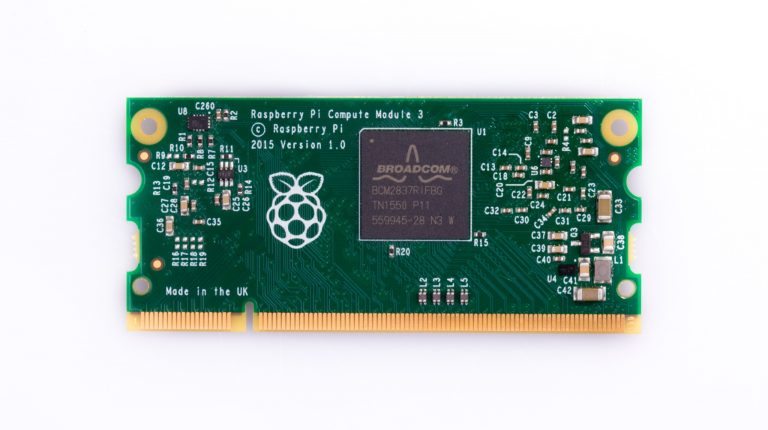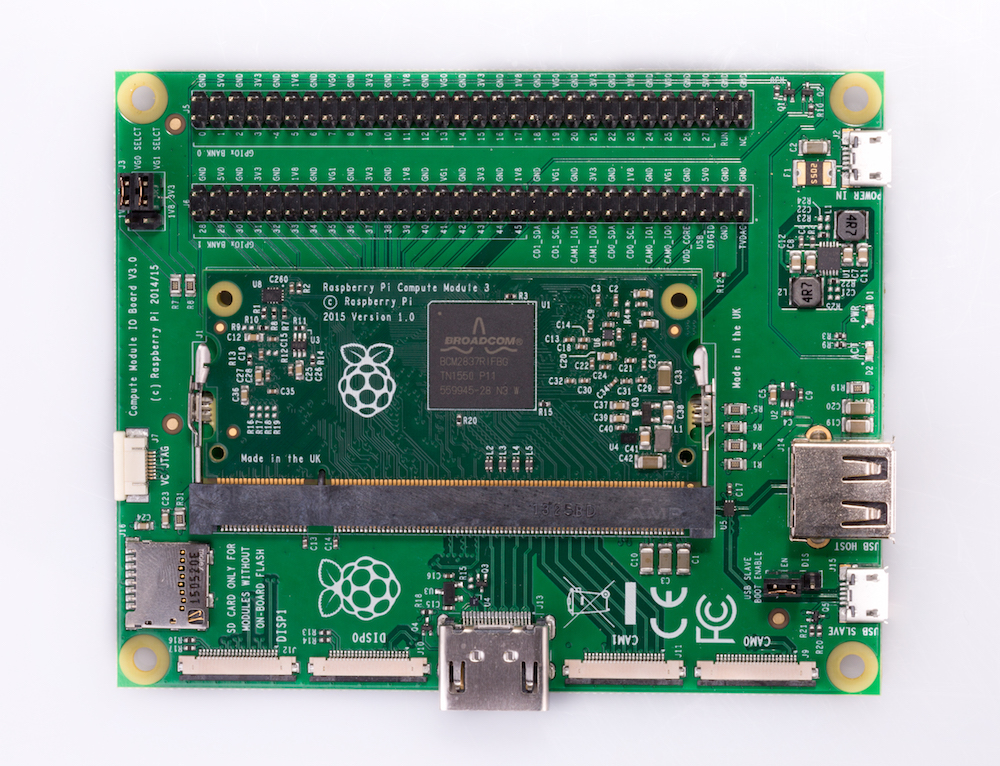Raspberry Pi Introduces Compute Module 3, Lite Version, And IO Board
Raspberry Pi released the Compute Module 3 and Compute Module 3 Lite to "provide the ‘team in a garage’ with easy access to the same technology as the big guys." The products are based on the consumer-focused Raspberry Pi 3 released in February 2016 with modifications for business customers.
The Compute Module 3 offers a BCM2837 processor at up to 1.2GHz, 1GB RAM (DDR2 SODIMM), and 4GB of on-module eMMC flash memory. The Compute Module 3 Lite comes with the same processor and RAM but forgoes the eMMC flash in favor of an SD card interface.
Raspberry Pi also released the Compute Module IO Board V3. It allows you to program the Module's flash memory, supplies the Module with power, offers an easier interface to the CPU, and provides the HDMI and USB connectors needed to build an entire system with your operating system of choice.
Hardware lead James Adams explained in a blog post how Compute Module 3 designs will differ from their predecessors:
The CM3 is largely backwards-compatible with CM1 designs which have followed our design guidelines. The caveats are that the Module is 1mm taller than the original Module, and the processor core supply (VBAT) can draw significantly more current. Consequently, the processor itself will run much hotter under heavy CPU load, so designers need to consider thermals based on expected use cases.
Updates from Raspberry Pi are always welcome. Its products offer an inexpensive way for people to learn software development, flirt with the idea of tinkering with hardware, and build cheap systems. That's why the Raspberry Pi 3 Model B made its way onto the Tom's Hardware 2016 Gift Guide.
The Compute Module 3 costs $30, and the Compute Module 3 Lite and the older Compute Module 1 cost $25. All three can be purchased from element14, Farnell, and RS Components now. RS Components is also selling the Compute Module IO Board V3 for roughly $118, whereas the other stores are selling $200 developer kits with both modules, the board, a camera display adapter, and other components.
Get Tom's Hardware's best news and in-depth reviews, straight to your inbox.

Nathaniel Mott is a freelance news and features writer for Tom's Hardware US, covering breaking news, security, and the silliest aspects of the tech industry.
-
WFang Seems very similar to the Colibri line of products from Toradex, with the added advantage of wider choice of cpu power and 'breakout' type boards.Reply
https://www.toradex.com/computer-on-modules/colibri-arm-family
-
bit_user I think it's funny to describe this as a cheap way to learn programming. Newegg has a Braswell N3050-based LIVA X2 system with 2 GB of RAM and 32 GB of EMMC for $130. And there are probably even cheaper compute-stick solutions that are at least as fast at the Pi.Reply
Clearly, Pi's seem aimed at hackers, hobbyists, and media streaming. I doubt very many of them are really being used as cheap desktop substitutes, even though that was their original, stated objective. -
Bloob Reply19173739 said:I think it's funny to describe this as a cheap way to learn programming. Newegg has a Braswell N3050-based LIVA X2 system with 2 GB of RAM and 32 GB of EMMC for $130. And there are probably even cheaper compute-stick solutions that are at least as fast at the Pi.
Clearly, Pi's seem aimed at hackers, hobbyists, and media streaming. I doubt very many of them are really being used as cheap desktop substitutes, even though that was their original, stated objective.
This has some goals beyond simple programming. If all you want is cheap, the Raspberry Pi Zero still exists and costs ~$5 (but requires a microsSD card for the OS).
-
bit_user Reply
I know about the Pi Zero, but heard that it was effectively unavailable, even a year after launch. Can you actually get them, now?19174986 said:If all you want is cheap, the Raspberry Pi Zero still exists and costs ~$5 (but requires a microsSD card for the OS).
From the sound of it, I figured it was just a publicity stunt or done for bragging rights. But it only counts if someone can actually get one.
Speaking about performance, the Pi Zero had the same specs as the original (which I own). IMO, it's too slow to be usable as a desktop (too slow for most things, really). I think there's better performance available at this price point (or that of its SoC) and much better performance in its power envelope.
I'm glad to hear these new modules are available with EMMC. The USB-connected SD card was long an Achilles Heel of the Pi. Gen 3 might actually be half decent, with EMMC (but I'd still prefer a Braswell or Apollo Lake).

